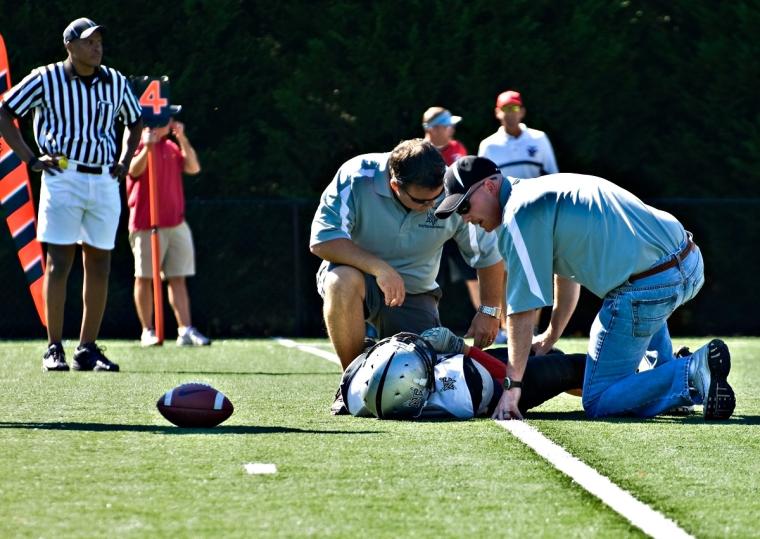
Serious knee injury is a major problem among high school sports participants. Anterior cruciate ligament (ACL) injuries, in particular, bring physical, mental and financial impacts that can last a lifetime. Research suggests that prevention programs can reduce the risk of ACL injury among young athletes. However, widespread implementation of prevention programming in high school sports remains limited.
To address this complex challenge, Hospital for Special Surgery (HSS) and the Aspen Institute have partnered to form the first national coalition to reduce ACL injuries. The National ACL Injury Coalition – which held its first in-person planning session in late March – envisions a sports ecosystem in which high school participants learn to move better and face fewer threats to serious injury, so they can remain active for life.
The coalition understands that the risk of non-contact ACL injury can be dramatically reduced through the adoption of exercises that improve athletic movement and allow athletes to change speed and direction with greater strength and body control. Research now demonstrates that this neuromuscular training can help protect athletes against many types of sports-related injuries, including ACL tears. Unfortunately, a major challenge has been the limited adoption of this type of training. A major strategic priority of the coalition is the development of policies, practices and partnerships that lead to athletes’ consistent participation in neuromuscular training. It will also grow awareness of the issue, promote equitable access to support, and foster alignment among key stakeholders.
The multiyear initiative represents a major activation of the Aspen Institute’s school sports research project with its call to prioritize health and safety. In addition to Aspen Institute and HSS, founding members of the National ACL Injury Coalition include:
- Players Health – Tyrre Burks, Founder and CEO
- Datalys Center for Sports Injury Research & Prevention – Christy Collins, President
- Centers for Disease Control and Prevention – Kelly Cornett, MS, Health Scientist
- US Youth Soccer – Skip Gilbert, CEO
- Hospital For Special Surgery – Jo A. Hannafin, MD, PhD, Sports Medicine
- New Jersey State Interscholastic Athletic Association – Colleen Maguire, Executive Director
- Cedars-Sinai Kerlan-Jobe Institute – Bert R. Mandelbaum, MD, Sports Medicine
- Emory University – Gregory D. Myer, PhD, FACSM, Sports Performance and Research Center
- National Federation of State High School Associations – Karissa Niehoff, CEO
- Major League Soccer – Holly Silvers-Granelli, PhD, MPT, Director of Research
“At HSS, the leading orthopedic hospital in the world, we are keenly aware that there is an opportunity to prevent approximately 50% of ACL injuries,” said Andrew D. Pearle, Chief of the Sports Medicine Institute at HSS. “Two decades of research and data have allowed us to develop simple training programs that mitigate ACL injury risk. The problem we face now is the implementation of these programs. Convening leading medical, sport, insurance, public health, and educational experts will create the type of coalition we need to develop a bold plan for action and achieve systems-level progress.”
High rates of ACL injuries among high school athletes can have an adverse effect on sports participation and performance in the near term as well as on overall health and physical activity across the lifespan. Those who suffer ACL injuries are seven times more likely to develop end-stage osteoarthritis that requires knee replacement. The median ACL reconstruction procedure costs $9,400 and total lifetime costs exceed $38,000, with the costs even higher ($88,000) for those who receive non-operative treatment.
However, not all athletes are at equal risk. Research shows female athletes are 1.5 times more likely to suffer an ACL injury than males. Adolescents playing team sports that require sudden change of direction (cutting, landing, stopping), like soccer, basketball, lacrosse, field hockey, ultimate frisbee, and flag and tackle football, face substantially heightened risk of ACL injuries. Meanwhile, public schools in low-income communities have fewer resources to implement ACL injury prevention programs. Youth from lower-income families are also less likely to have health care insurance as well as access to adequate medical care after an injury.
A flood of recent ACL injuries in professional women’s soccer highlights the urgency of this public health crisis. Internationally, 57 ACL injuries occurred among the six major women’s professional leagues in 2022. Within the U.S. national team that defends its title in the FIFA Women’s World Cup starting in July, Catarina Macario, Christen Press and Tierna Davidson have suffered an ACL injury in the past six months, while Alex Morgan, Megan Rapinoe, Ashlyn Harris and Ali Kriefer tore the ligament in prior years.
“If we’re going to build healthy people and communities, we need to reckon with the underappreciated problem of athlete knee injuries that could be prevented,” said Tom Farrey, executive director of the Aspen Institute’s Sports & Society Program. “The problem needs the same attention that has gone to reducing brain injuries, given the importance of healthy knees to moving well and the physical, mental and emotional benefits that flow to those whose bodies stay in motion throughout adulthood.”
More information can be found online here.

There are no comments
Please login to post comments